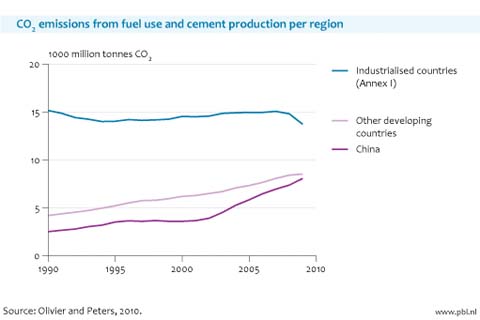July 2 2010 10:38 am
Global CO2 Trends Show Scope of Climate Challenge
By ANDREW C. REVKIN
1:16 p.m. | Updated
Theres still thinking in many quarters that if the United States acts to restrict its emissions of carbon dioxide the long-lived greenhouse gas at the heart of the climate challenge the fast-growing developing countries of the world will voluntarily follow. Global data on emissions of carbon dioxide vividly illustrate the wishful nature of such thoughts when considered against powerful underlying trends.
The latest analysis by the Netherlands Environmental Assessment Agency described at the Green blog and Roger Pielke Jr.s blog shows how the decline in per-capita emissions from the deep recession was overcome by growth in the industrializing world.

The graph above from the Dutch report shows clearly how relentless overall emissions growth in countries climbing out of poverty (as electrification manufacturing and mobility expand fossil fuel demand) was not blunted by the recession and is sending them and the rich world (which is getting ever more efficient and exporting manufacturing) toward some kind of carbon common ground.
On a per-capita basis this is even more apparent. China and France for very different reasons now have roughly the same emissions of carbon dioxide per citizen about 6 tons per person per year. Frances are very low because of the dominance of nuclear power there; Chinas are very low because a huge portion of its population still is barely connected to the energy-intense world of electrical power and personal vehicles. Click here for the reports chart of per-capita emissions in rich and developing countries in 1990 and 2009.
The scope of the greenhouse challenge is appreciated when you play out these trends. Even if the United States hits the goal of a 17-percent cut in CO2 emissions by 2020 articulated by President Obama and allies in Congress and Europe hits its pledged targets even if the rich North magically does the super-deep cuts articulated by world leaders for 2050 simple math shows unerring growth in global emissions unless the developing world follows suit.
And leaders in the developing world have made it abundantly clear that economic growth and energy security trump climate as a priority. Re-read Keith Bradshers recent assessment of Chinas energy priorities. As has long been clear energy security completely trumps climate stability as a priority. India is as determined as ever to sustain its economic growth and demand help from the rich world for any costly diversion from conventional coal burning to fuel that growth.
So you say you want a revolution?
Keep in mind where the growth in fuel burning exists and the priorities in those places. And next December when the talks over a climate treaty resume in Cancun Mexico remember the equity issue that so divides the worlds nations. India has said its happy to stay below our CO2 emissions rate on a per-capita basis. But India is heading toward a population of more than 1.5 billion by 2050[*] with Indians far outnumbering Chinese at that point.
At a meeting in Washington a couple of years ago Michael Shellenberger of the Breakthrough Institute told a variant of a slightly bawdy joke my sons enjoy. The standard joke simply involves adding the words in bed to the phrase in any fortune cookie.
In Shellenbergers variant you need to add the words in China to any claim about the role of an energy technology or policy in fighting global warming and see if it still holds up. Actually with India poised to be the next China doubling its population by 2050 even as it industrializes maybe Shellenbergers quip needs updating.
All of this reinforces the need if you take the climate challenge seriously to get busy on that energy quest.
[*] The post has been updated to fix an errant population estimate for India in 2050 (2 billion; thats Africas projected population by then).



